2015 – Grizzly Peak Airfield
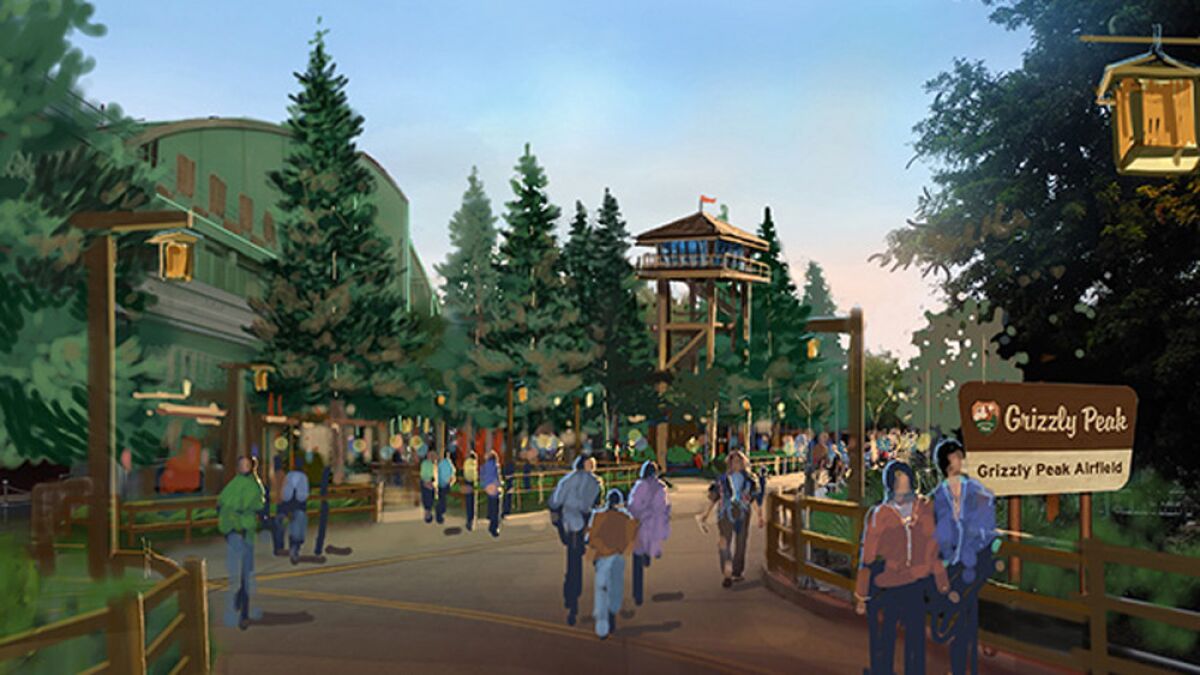
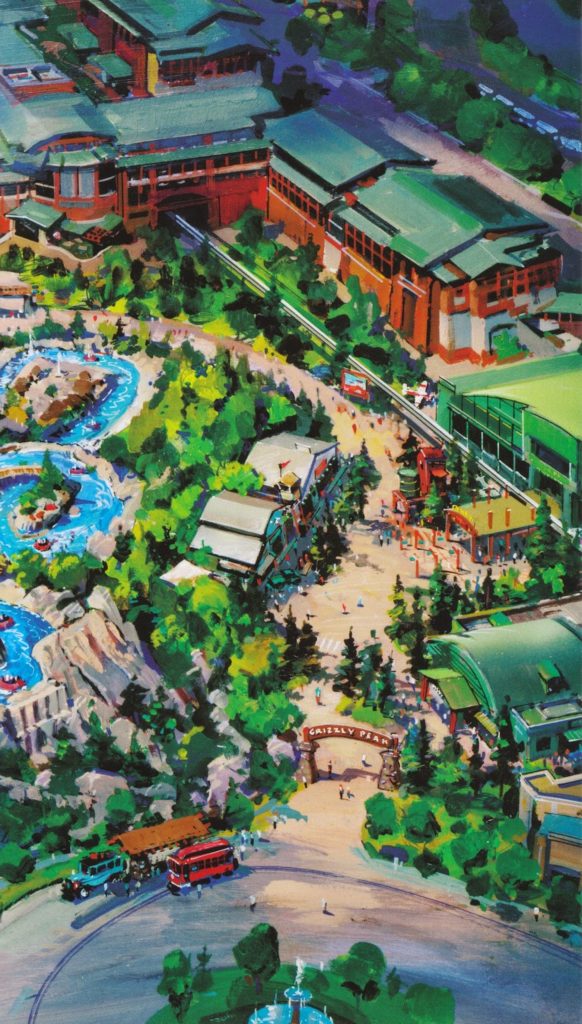
When California Adventure “re-opened” in 2012, it had eight lands – as many as Disneyland at the time. Three years later, the then-recently-relaunched park actually lost a land when Condor Flats was wiped off the map. It made sense. Condor Flats had only been “upgraded” to full land status in 2012, but the small plaza wedged between the Soarin’ hangar and the forested slopes of Grizzly Peak had never really come across as an arid, high-altitude, desert landing strip. Plus, the area’s barren, beige, “industrial scrapyard” appearance of rebar, rocket engines, and corrugated steel felt like a major drop-off branching off of the warmth of Buena Vista Street.
Absorbing the area (including Soarin’) into the adjacent Grizzly Peak National Park aesthetic and narrative made great sense, and Imagineering hit the ground running.
The “Grizzly Peak Airfield” mini-land was transformed wonderfully, including resculpting and repainting desert rocks to blend in with the gray, granite rock faces of Grizzly Peak, removing the land’s “industrial flight testing” rebar and steel in favor of wooden watchtowers, and planting evergreens across the area. Rather than a desert landing strip, the Airfield looked like a forest runway from which planes might take off to douse wildfires.
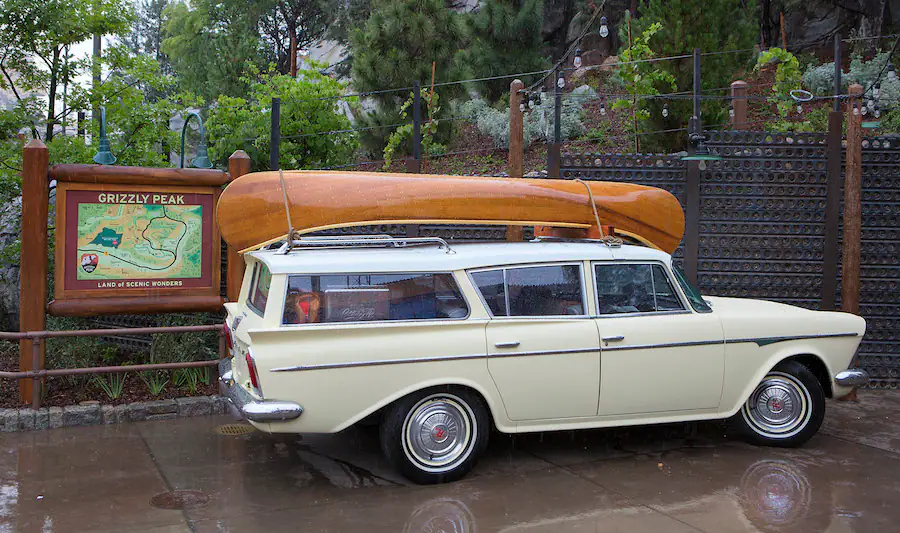
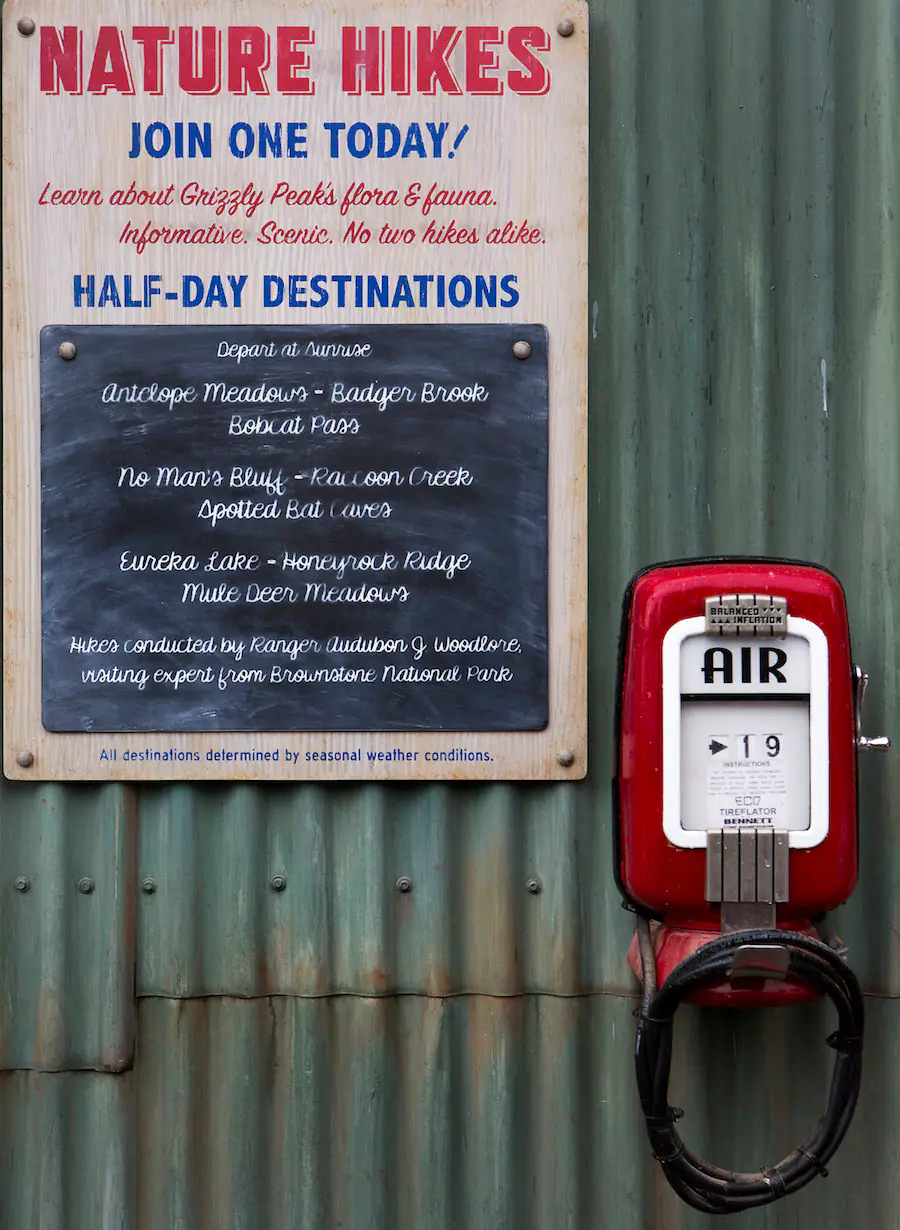
More importantly, the new Grizzly Peak Airfield also drew heavily from the rest of Grizzly Peak’s 2012 relaunch, setting the Airfield’s clocks to the 1950s. A family’s parked Rambler (complete with a canoe on the roof) recalled the great American road-trip; National Park preservation signs subtly integrated characters from 1942’s Bambi while display windows touted the opening of Disney’s 1955 film Davy Crockett: King of the Wild Frontier…
The land’s restaurant was stripped of its modern ornamentation and turned into a canteen for California’s “Smokejumpers” (real Forest Service firemen); Soarin’s airplane hangar was redressed in wooden signage and repainted as a discreet forest airfield would require; modern industrial runway lights became craftsman lanterns suspended from wooden posts; and just as Buena Vista Street highlighted Oswald, the cartoon bear Humphrey from Disney’s 1950s animated shorts overtook the land’s retail space – another nod to classic Disney cartoons lovingly integrated into a historic Californian locale.
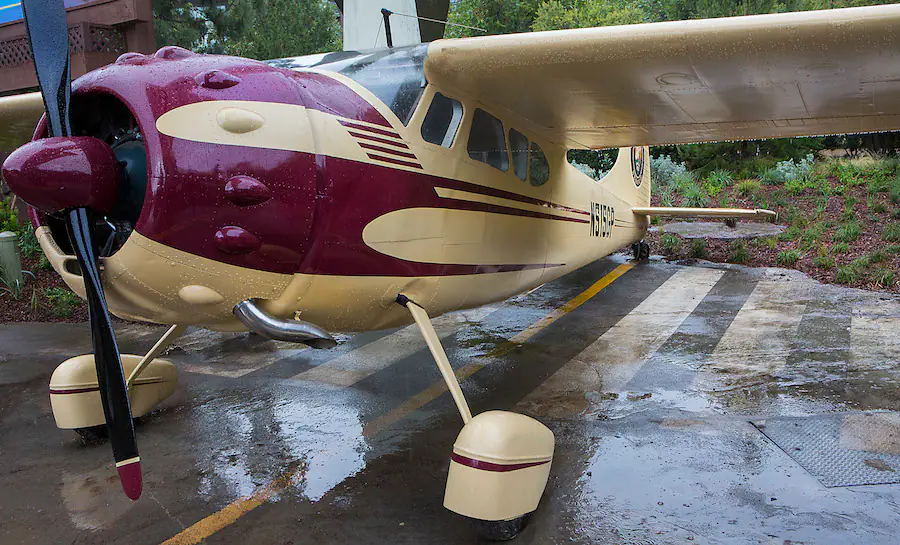
Even the land’s custom-made Cessna 195 propeller plane was redressed in period-appropriate colors, fixtures, and interiors, replacing its tin appearance and “Condor Flats Air Tours” tail fin logo with a color palette and the emblem of Grizzly Peak National Park.
All that is to say that for fans, the Grizzly Peak Airfield wasn’t just a “Phase II” project drawn from the “DCA 2.0” mindset; it was evidence that this was indeed the path Disney had set for California Adventure. That historic, idealized, Californian lands thoughtfully integrating Disney characters would indeed continue as further phases of reinvestment came to the still-growing park.
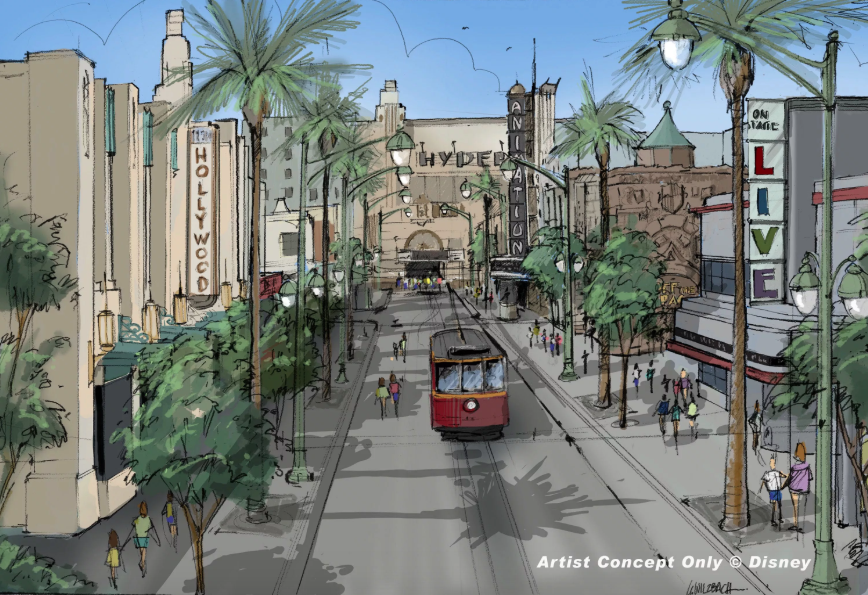
Maybe Hollywood Land would be next, finally receiving the true, in-depth, floor-to-ceiling placemaking package that had been teased as part of California Adventure’s rebirth (above), but that the initial billion dollars clearly hadn’t covered… In the wake of Grizzly Peak Airfield, it didn’t just seem possible, it seemed likely.
But almost as quickly as Disney had doubled down on “DCA 2.0” in Grizzly Peak Airfield, a confounding switch signaled that the park’s recent re-orientation would be short-lived…
2016 – Soarin’… but not Over California
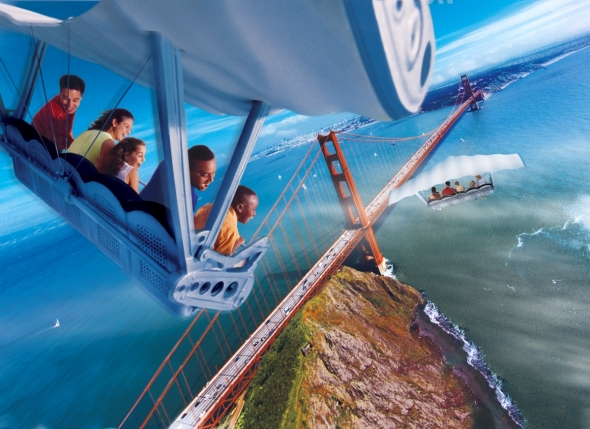
Back in 2001, Soarin’ Over California was the reason to visit Disney’s California Adventure Park. In fact, many argue that it was the only sincere success to emerge from the underbuilt second gate. So much so that the ride was duplicated in EPCOT’s The Land pavilion in 2005, and even though it used the same “Over California” ride film, the varied landscapes of California made the ride’s inclusion merely as “Soarin'” unsuspicious!
As it had at California Adventure, the ride became a signature of EPCOT, earning multi-hour waits. Rumors had always swirled that eventually, EPCOT’s version of the ride would be given a custom-made ride film touring over the natural landscapes of the country (an obvious fit for The Land pavilion).
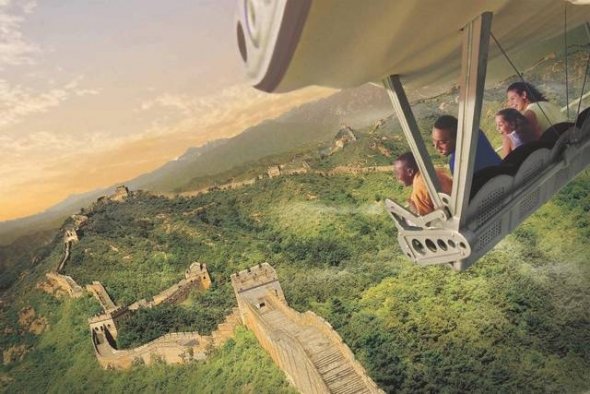
The brand new Shanghai Disneyland beat them to it when, on its opening day – June 16, 2016 – the Chinese park introduced Soarin’ Over the Horizon. Located in the park’s Adventure Isle, the new edition of Soarin’ came pre-stocked with a new ride film showcasing architectural landmarks and natural wonders from around the world – the Great Wall of China, the Eiffel Tower, Neuschwanstein Castle in Germany, Great Pyramids, the Taj Mahal…
The day after the ride made its debut in Shanghai, it replaced the original Soarin’ ride film at EPCOT. And really, the decision to replace Epcot’s Soarin’ with the global Soarin’ Around the World was a no-brainer – a natural and overdue evolution of the 15-year-old ride, even if the aerial tour of mostly-man-made landmarks technically made it no better a fit for The Land pavilion than the Californian ride film had been.
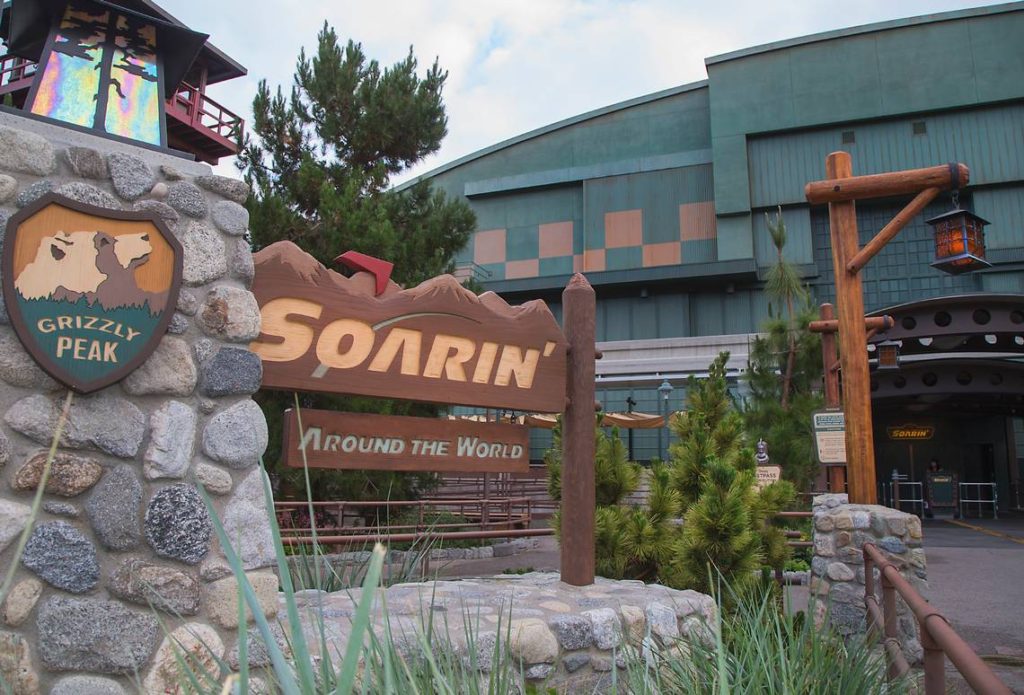
But that same day, Soarin’ Around the World replaced the original ride at California Adventure, too, in the still-fresh Grizzly Peak Airfield. The fan-favorite that launched a generation of “Soarin’” attractions and proved that California Adventure did have a concept worth rallying around would change. It’s not that Soarin’ Around the World isn’t beautiful and moving and well done – it is! It’s that the original ride film was custom-made for a park dedicated to celebrating California’s stories. Flying over Mount Kilimanjaro and the Sydney Opera House doesn’t fit.
(It’s especially curious that Disney wouldn’t simply play the Californian ride film in one of Soarin’s two theaters and the global version in the other. Instead, “Over California” makes predictable McRib style returns each year to bolster the park’s attendance during seasonal festivals – admission of its popularity over the cooly-received worldwide spin-off.)
So while Disney had spent immense time, energy, and money re-theming Condor Flats to the beautifully forested, more overtly-Californian, historic and idealized Grizzly Peak Airfield, its sole attraction – one of the anchor attractions of the Californian park – would now lose its Californian ride film… It was weird, but maybe it would be a brief and anomalous misstep? Well…
2015 – 2016 – Frozen Fun & Frozen – Live at the Hyperion
In retrospect, it’s no surprise that so much of California Adventure’s 2012 reimagining centered on Pixar (Monsters Inc., A Bug’s Life, Toy Story, Cars) with only the occasional hint of home-grown Disney characters (The Little Mermaid). After all, you have to remember that when California Adventure’s rebuild was initiated in 2007, Disney itself hadn’t had a home-grown, enduring, animated hit in a decade while Pixar (which Iger acquired the year prior) heralded an unbroken string of critical and commercial hits and a character catalogue quickly growing to meet and even exceed Disney’s pop culture dominance.
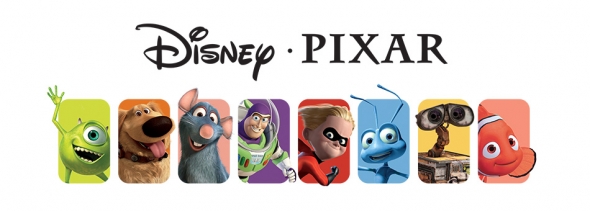
Especially since the $7.4 billion Pixar purchase was seen as a brazen and risky first move for the still-new CEO, a corporate all-call had been issued with instructions to use the newly-acquired Pixar’s characters and brands across the company. In that context, it did make good sense that California Adventure’s rebirth would tap into the Golden State for style while leveraging the newly-acquired Pixar as its substance.
It wasn’t until California Adventure’s five year plan and heavy construction was already in motion that Disney’s own animation studio found itself at the beginning of a new “Revival” with 2009’s The Princess and the Frog and 2010’s Tangled. Even so, neither were the kind of blockbuster hit Disney hoped for, and neither was rushed into the parks.
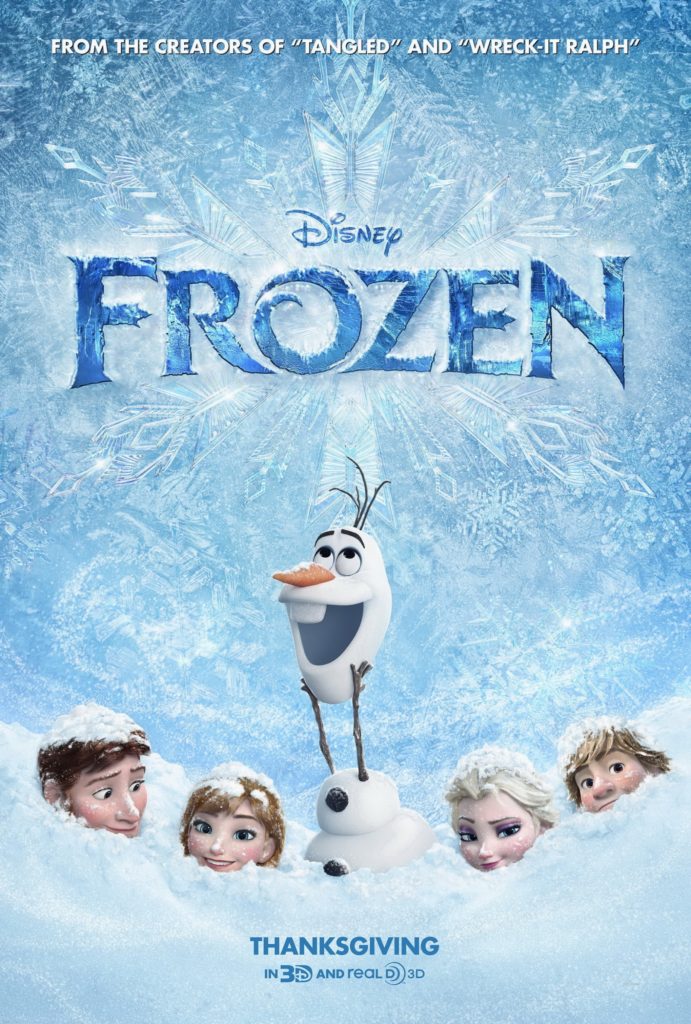
That changed in November 2013 when Disney’s Frozen hit theaters. Through what was initially a slow burn, Frozen grew into something unstoppable. By the end of 2013, lines to meet the film’s dual princesses, Anna and Elsa, stretched for hours, overwhelming the capacity of temporary, promotional, in-park meet-and-greet spaces financed (as is tradition) by the studio’s marketing campaign. And unlike most tie-in promotional character greetings, interest in Anna and Elsa didn’t wane when marketing’s investment did.
In March 2014, Frozen officially became the highest-grossing animated film of all time (surpassing Disney’s own The Lion King and Pixar’s Toy Story 3). Momentum didn’t slow. It wasn’t until April 2014 – five months after the movie’s release – that soundtrack anthem “Let It Go” peaked at number five on the Billboard music charts (the first song from a Disney animated musical to do so since Pocahontas; “Let It Go” eventually won an Academy Award and a Grammy Award).
Today, with nearly $14 billion in revenue, Frozen ranks among the highest-grossing media franchises of all time, having earned more money than Spongebob Squarepants, The Peanuts, Power Rangers, and even Star Trek – to say nothing of Frozen’s boost to the separate $46 billion Disney Princess franchise.
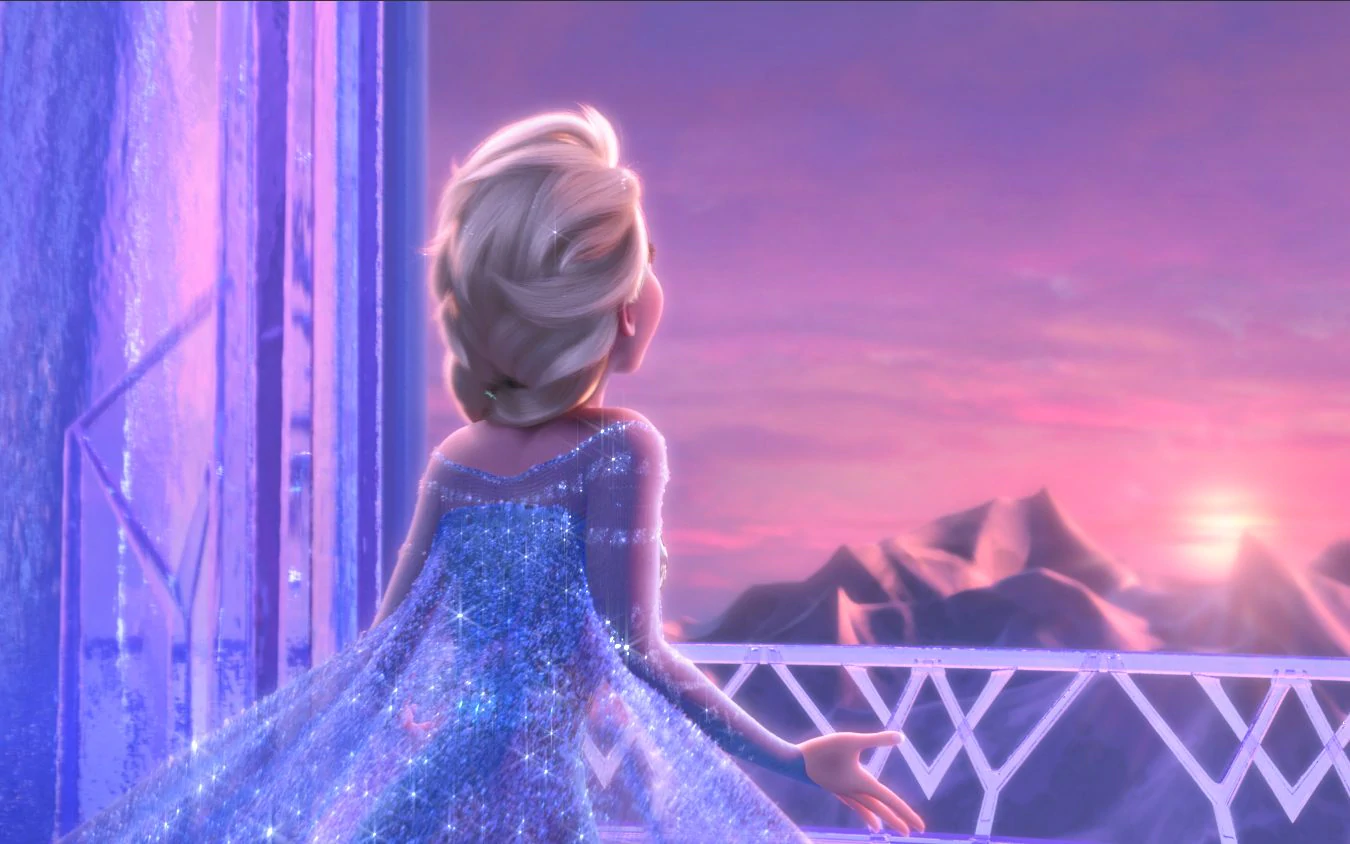
Frozen fever had officially overtaken the world, and for the first time in at least two decades, Disney Feature Animation had an undeniable, blockbuster, global mega-hit of their very own. It’s often said that no one was more surprised by Frozen’s success than Disney who, for the first time in forever, found itself with more demand than supply for a new animated franchise… and an all-out race to meet that demand in their parks.
In September 2014, Walt Disney World announced that EPCOT’s Norway pavilion would undergo a multi-phase expansion that would introduce a new, permanent, high-capacity Anna and Elsa meet-and-greet while also replacing the Lost Legend: Maelstrom with a permanent Frozen dark ride (cleverly turning EPCOT from a maybe to a must-see for families with Disney Princess fans.)

At Disneyland, Frozen would arrive via an entire annual promotion – “FROZEN FUN” – that would primarily take root at… Disney California Adventure.
During the park’s long, multi-year build-out, the park’s barren “Hollywood Studios Backlot” had been largely ignored, with only simple painting, placemaking, and planters to speak of. As a result, the very large and mostly-unused space was recruited to host a rotating cast of after-dark drink-and-dance parties like Glow Fest (2010), ElecTRONica (2010 – 2012), and the Mad T Party (2012 – 2014).
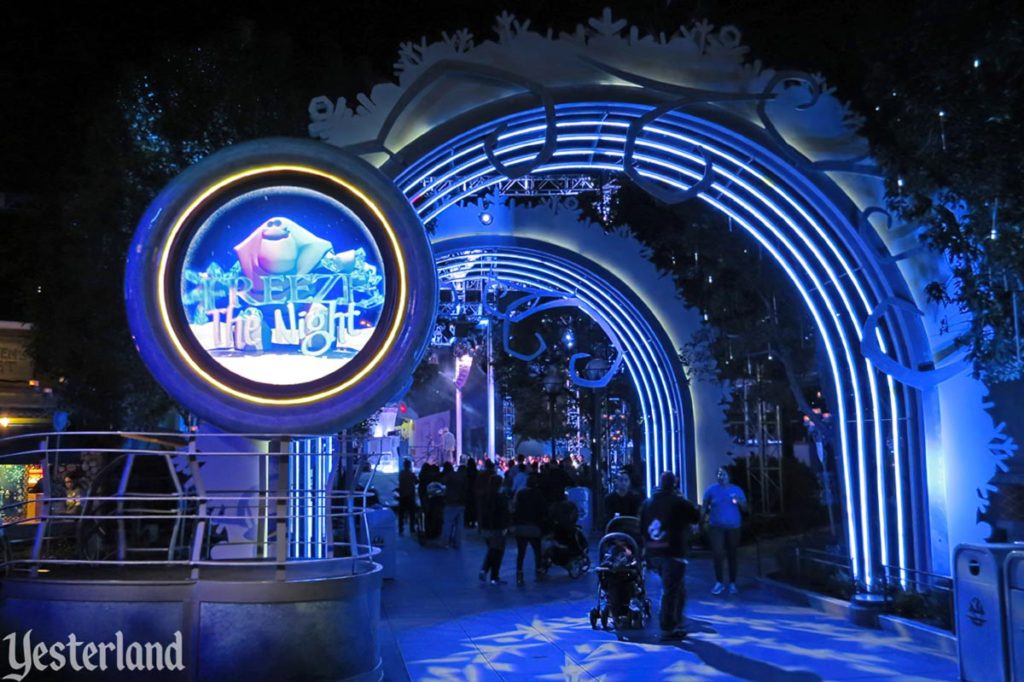
In January 2015 (14 months after Frozen had debuted), the dance party infrastructure was re-used as Freeze the Night! A Family Dance Party – a curious fusion of the rave-like, DJ-led, alcohol-centered event formula with more family offerings like ice carving, meet-and-greets, snow machines, and of course, nightly sing-alongs of “Let It Go”.
Speaking of which, the Muppet*Vision 3D theater in Hollywood Land was closed in order to house For the First Time in Forever – A Frozen Sing-Along Celebration. (It did not return even once “Frozen Fun” ended.)
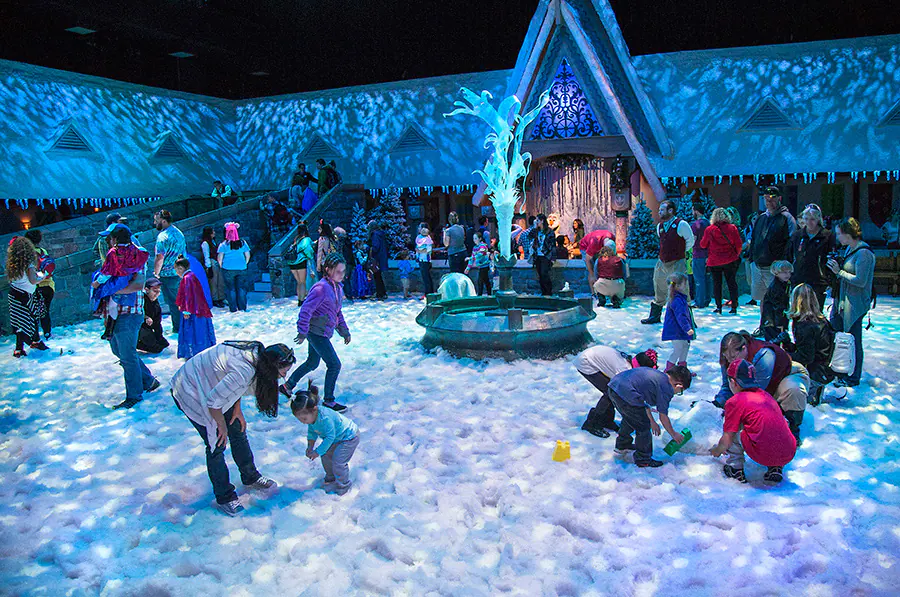
Next door, the backlot’s Stage 17 (the large studio building constructed for “Who Wants To be a Millionaire – Play It” in 2002 and then promptly abandoned and left as empty set-dressing in 2005) was reactivated with Olaf’s Snow Fest – an indoor Arendellian “town square” offering a snow play zone, a small “sled hill” (novel for many Southern Californians!), an Olaf meet-and-greet, and limited time Olaf-themed snacks and hot chocolate.
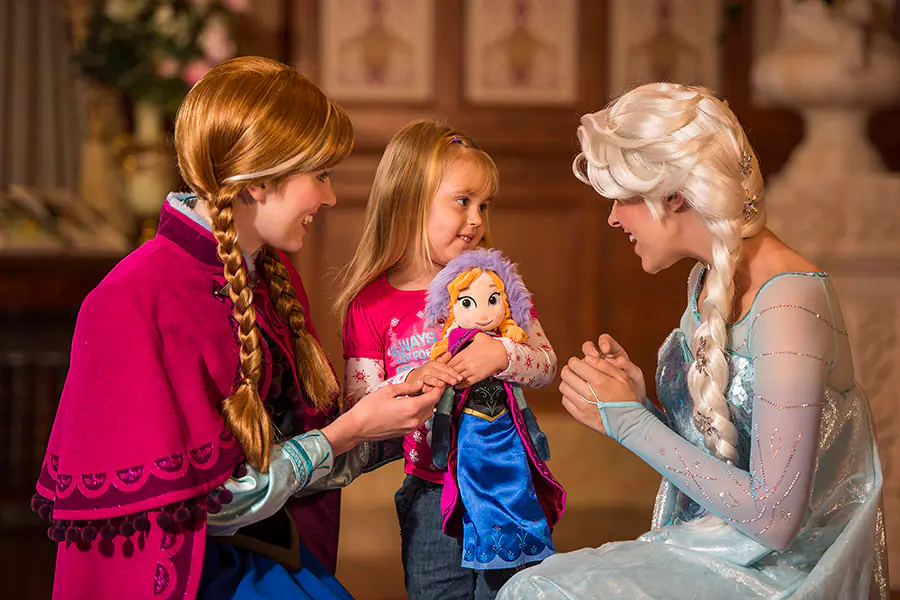
After toggling between temporary spaces across the resort to meet demand, a Frozen meet-and-greet finally settled into a portion of Hollywood Land’s Animation Building (replacing the “Character Close-Up” Toy Story zoetrope exhibit and the “Ursula’s Lair” chamber of the Sorcerer’s Workshop). The new Anna & Elsa’s Royal Welcome remains in that space to this day.
For all the pomp and circumstance, the “Frozen Fun” celebration was relatively short-lived, ending just 9 months after it began, in autumn 2015. Anyone who lived through the era will tell you that by then – two years after the film’s release – even die-hard fans were wearing thin in their patience for “Let It Go,” and particularly of Frozen’s almost outlandishly wide takeover of Disney’s theme parks.
When it seemed that the Frozen fever had at last subsided, Disney made one more surprise announcement. The long-running and deeply-adored “Aladdin – A Musical Spectacular” would end its run in Hollywood Land’s Hyperion Theater to be replaced with (you guessed it) Frozen.
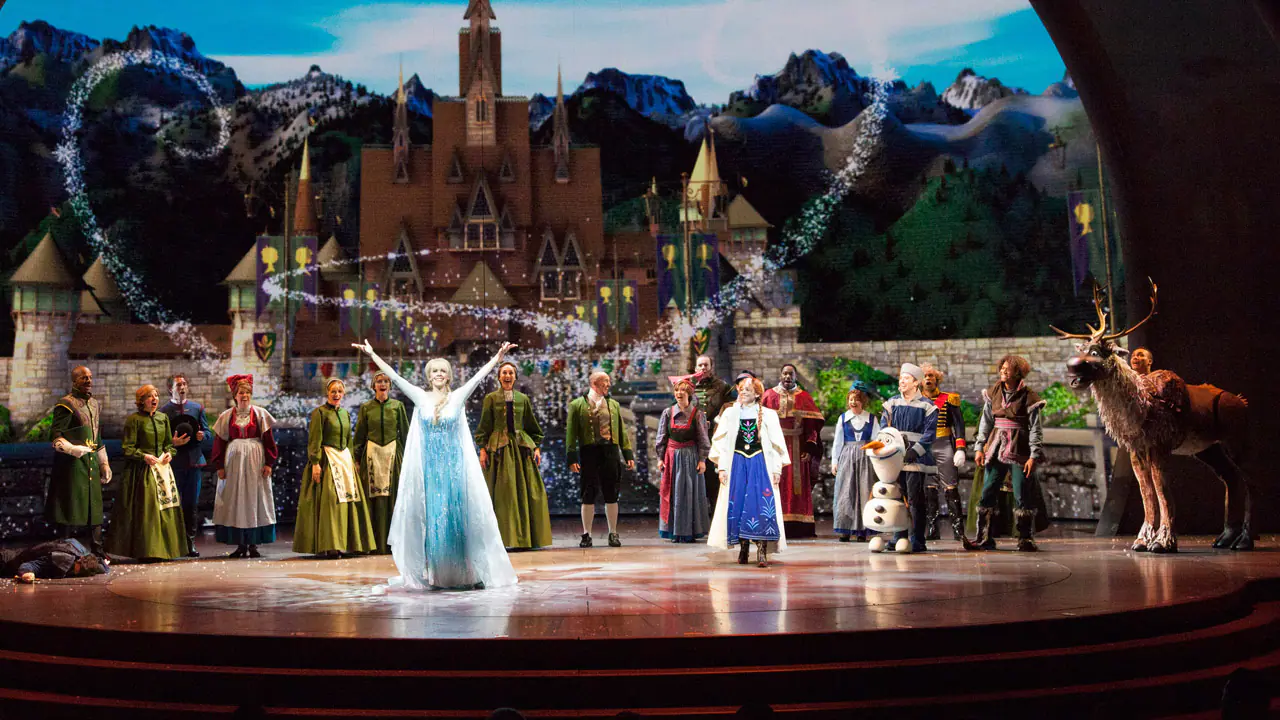
Debuting May 2016, Frozen – Live at the Hyperion bested Aladdin’s already-astounding 45-minute runtime with a gob-smacking hour-long reenactment of the film. (If anything, the live stage version of Frozen was a test run for the 2018 Broadway rendition. But as a theme park show, its line-by-line, note-for-note, scene-by-scene, laboriously-exacting restaging of the film largely fell flat versus the more nimble, humorous, physical “Aladdin” led by a wise-cracking, ad-libbing Genie whose repertoire of pop culture references kept audiences coming back. Like its Broadway sister, California Adventure’s “Frozen” show closed with the pandemic and never re-opened.)
Especially given the real estate available in California Adventure’s Hollywood Land and the continued need to route families into the park, you can’t really fault Disney for centering its Frozen promotion there. Likewise, it’s not like the properties that Anna and Elsa overtook by eminent domain (Ursula’s Lair in the Animation Building, “Aladdin – A Musical Spectacular” in the Hyperion, and Muppet Vision) had any more thematic right to occupy California Adventure than the storybook sisters did…
But it seemed that the “Frozen Fun” promotion had been another odd step away from the park’s “2.0” ethos – made all the more obvious when the pandemic forced Anna and Elsa out of their enclosed meet-and-greet space in the Animation Building to instead greet guests on… Buena Vista Street?
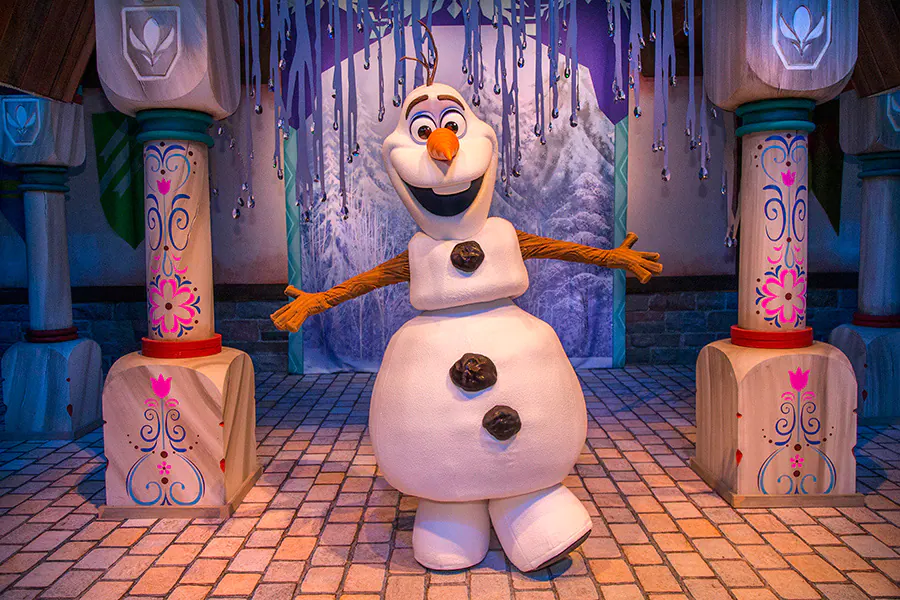
In such a broad-strokes retelling of the park’s story, it may seem silly to waste precious words on a temporary and altogether harmless promotional event like “Frozen Fun” (even if it did permanently strike Muppet Vision and “Aladdin – A Musical Spectacular” from the California Adventure’s lineup).
But in the bigger picture, Frozen had also taught Disney a valuable lesson. Now a hitmaker once more, Disney seemed to sideline its longstanding standard of restricting attractions to well-trodden films whose longevity had been proven, adopting a de facto policy that positioned the parks as promotional centers for current properties and franchises. In other words, after Frozen, Disney seemingly vowed to act quickly to get the next blockbuster franchise into the parks while it was still hot. And where else but California Adventure…?


